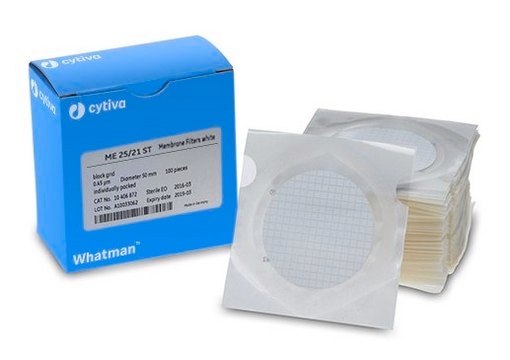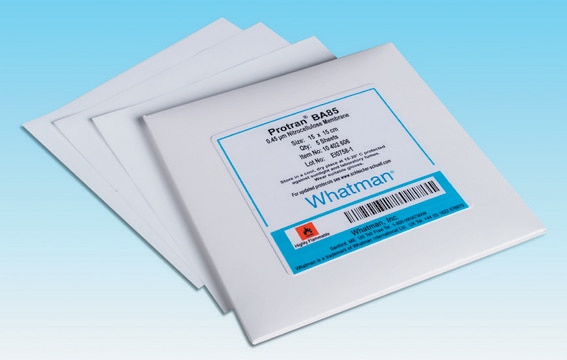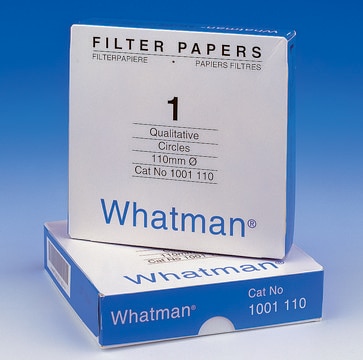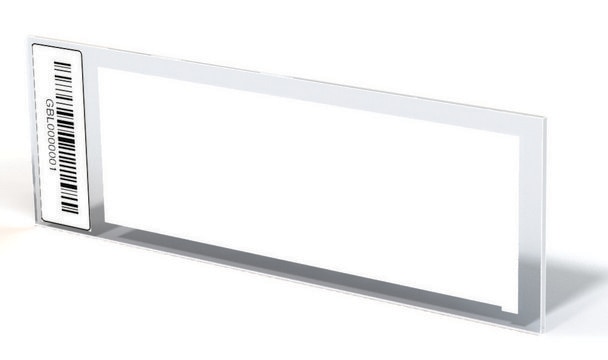WHA7141004
Whatman® mixed cellulose ester membrane filters
gridded white, pore size 0.45 μm, diam. 47 mm, pack of 100 ea
Synonym(s):
Whatman® nitrocellulose membrane filters, Whatman filter, Z745820, membrane filters, syringe filter
About This Item
Recommended Products
material
gridded white
sterility
non-sterile
packaging
pack of 100 ea
manufacturer/tradename
Whatman 7141-004
Whatman Article No. 28420718 (US reference)
diam.
47 mm
pore size
0.45 μm
Looking for similar products? Visit Product Comparison Guide
Related Categories
General description
Higher strength and flexibility:
Most membranes are inherently brittle and difficult to handle; it is not uncommon for filters to be damaged during loading into holders or while in use. Whatman mixed cellulose ester membrane filters have a noticeably improved flexibility and are made to tolerate abuse during handling, loading and autoclaving without sacrificing integrity. These membranes are among the strongest of their type available, as measured and compared by burst pressure tests.
Low extractable levels:
The level of extractables in membrane filters has become more important with advances in filtration or adsorption techniques. In particular, pharmaceutical, immunological and biomedical tissue culture and trace analysis applications can be adversely affected by high extractable levels. Whatman mixed cellulose ester membrane filters have a low level of extractables, generally below that of other membranes of a similar type.
Narrow pore size distribution:
One of the major features of Whatman membrane filters is the narrow distribution of pore sizes. The rated pore size of these membranes is closely controlled due to the advanced manufacturing and control system. Additionally, the batch-to-batch variation is minimized providing more consistent laboratory results.
Increased temperature stability:
Membrane filters are normally autoclaved at 121°C without loss of integrity. Cellulose nitrate membranes are supplied as circles, sheets or reels.
Reduced shrinkage:
Excessive shrinkage can cause problems during autoclaving and is often the cause of membranes tearing in their holders after autoclaving. It may also cause a reduction in flow rate and total throughput. Whatman membranes exhibit a low shrinkage during autoclaving.
Applications:
Sample preparation
Microbiological studies
Filtration of aqueous solutions
Higher strength and flexibility:
Most membranes are inherently brittle and difficult to handle; it is not uncommon for filters to be damaged during loading into holders or while in use. Whatman cellulose nitrate membrane filters have a noticeably improved flexibility and are made to tolerate abuse during handling, loading and autoclaving without sacrificing integrity. These membranes are among the strongest of their type available, as measured and compared by burst pressure tests.
Low extractable levels:
The level of extractables in membrane filters has become more important with advances in filtration or adsorption techniques. In particular, pharmaceutical, immunological and biomedical tissue culture and trace analysis applications can be adversely affected by high extractable levels. Whatman cellulose nitrate membrane filters have a low level of extractables, generally below that of other membranes of a similar type.
Narrow pore size distribution:
One of the major features of Whatman membrane filters is the narrow distribution of pore sizes. The rated pore size of these membranes is closely controlled due to the advanced manufacturing and control system. Additionally, the batch-to-batch variation is minimized providing more consistent laboratory results.
Increased temperature stability:
Membrane filters are normally autoclaved at 121°C without loss of integrity. Cellulose nitrate membranes are supplied as circles, sheets or reels.
Reduced shrinkage:
Excessive shrinkage can cause problems during autoclaving and is often the cause of membranes tearing in their holders after autoclaving. It may also cause a reduction in flow rate and total throughput. Whatman membranes exhibit a low shrinkage during autoclaving.
Applications:
- Sample preparation
- Microbiological studies
- Filtration of aqueous solutions
Other Notes
Legal Information
signalword
WarningDanger
hcodes
Hazard Classifications
Flam. Sol. 1
Storage Class
4.1B - Flammable solid hazardous materials
wgk_germany
WGK 3
Certificates of Analysis (COA)
Search for Certificates of Analysis (COA) by entering the products Lot/Batch Number. Lot and Batch Numbers can be found on a product’s label following the words ‘Lot’ or ‘Batch’.
Already Own This Product?
Find documentation for the products that you have recently purchased in the Document Library.
Customers Also Viewed
Our team of scientists has experience in all areas of research including Life Science, Material Science, Chemical Synthesis, Chromatography, Analytical and many others.
Contact Technical Service






